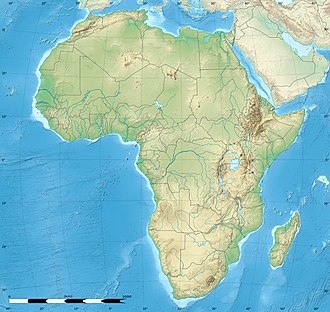Top Qs
Timeline
Chat
Perspective
La Güera
Ghost town in Western Sahara From Wikipedia, the free encyclopedia
Remove ads
La Güera (Arabic: الگويرة, Hassaniyya pronunciation: [ˌəl.əgwäyrə]; also known as La Agüera, Lagouira, El Gouera) is a ghost town on the Atlantic coast at the southern tip of Western Sahara, on the western side of the Ras Nouadhibou peninsula which is split in two by the Mauritania–Western Sahara border, 15 kilometres (9.3 mi) west of Nouadhibou. It is also the name of a daira at the Sahrawi refugee camps in south-western Algeria.
This article needs additional citations for verification. (November 2024) |
It is the southernmost town of Western Sahara. La Güera is situated about 65 kilometres (40 mi) south of the Moroccan Wall at Guerguerat and is technically abandoned.
Remove ads
History
Summarize
Perspective
The name La Güera comes from the Spanish word Agüera which is a ditch that carries rainwater to crops.
Foundation and settlement

La Güera came into existence in late 1920, when Spanish colonizer Francisco Bens (who had earlier taken possession of the Cape Juby region as a protectorate in 1916), after negotiating with tribal chiefs of the zone, established a fort and an air base on the western side of the Ras Nouadhibou peninsula, just a few kilometers away from the French settlement of Port-Étienne (now Nouadhibou) on the eastern side of the peninsula. (In the 1912 Convention of Madrid, Spain and France had agreed on a border between Mauritania and Spanish possessions that ran down the middle of the peninsula.)
In 1924, La Güera was incorporated into the Spanish colony of Río de Oro. During the short period (1920–1924) that the town was ruled as a separate part of the colony it released its own postage stamps.[1][2] The town was served by La Güera Airport until the 1970s.
Western Sahara War
In 1979, when Mauritania withdrew from the war, La Güera's population was estimated to be 816 inhabitants.[3]
Since the Alegal Madrid Tripartite Agreement of 1975 it remains Territory in dispute. Before the long Sahrawi liberation war, the city was famous for its rich marine fauna: the monk seal as a symbol of the City, cetaceans and the special relationship of symbiosis in the art of fishing of these (dolphins) with fishermen belonging to the segment of the Sahrawi population most attached to Berber customs whose Amazigh language was still preserved, in the highest proportion of the territory, in addition to techniques and linguistic terms in common with Spanish fishermen from the Canary Islands and brothers of the same ethnic group imraguen, from the Mauritanian side. The times when the Canary-Saharan fishing bank functioned at full capacity for the local people are now only memories of the yesterday.[4][5][6]
By 2002, it had been still abandoned and partially overblown by sand, inhabited only by a very few Imraguen fishermen[7][8] and guarded by a Mauritanian military outpost, despite this not being Mauritanian territory.[8]
Remove ads
Twin towns and sister cities

 Águilas, Murcia, Spain (since July 18, 2005)[9]
Águilas, Murcia, Spain (since July 18, 2005)[9] Alaquàs, Valencia, Valencian Community, Spain (since April 14, 2004)[10]
Alaquàs, Valencia, Valencian Community, Spain (since April 14, 2004)[10] Almansa, Albacete, Castilla-La Mancha, Spain [11]
Almansa, Albacete, Castilla-La Mancha, Spain [11] Castagneto Carducci, Livorno, Tuscany, Italy[12]
Castagneto Carducci, Livorno, Tuscany, Italy[12] Crevillent, Alicante, Valencian Community, Spain[13]
Crevillent, Alicante, Valencian Community, Spain[13] El Puerto de Santa María, Cádiz, Andalucía, Spain (since 1993)[14]
El Puerto de Santa María, Cádiz, Andalucía, Spain (since 1993)[14] Fauglia, Pisa, Tuscany, Italy (since 2009)[12]
Fauglia, Pisa, Tuscany, Italy (since 2009)[12] Gorliz, Biscay, Basque Country, Spain[15]
Gorliz, Biscay, Basque Country, Spain[15] Guadix, Granada, Andalucía, Spain
Guadix, Granada, Andalucía, Spain Iurreta, Biscay, Basque Country, Spain[16]
Iurreta, Biscay, Basque Country, Spain[16] Leganés, Madrid, Spain (since August 17, 2001)[17]
Leganés, Madrid, Spain (since August 17, 2001)[17] Londa, Florence, Tuscany, Italy (since 2017)[18]
Londa, Florence, Tuscany, Italy (since 2017)[18] Monteriggioni, Siena, Tuscany, Italy[12]
Monteriggioni, Siena, Tuscany, Italy[12] Orio, Gipuzkoa, Basque Country, Spain[19]
Orio, Gipuzkoa, Basque Country, Spain[19] San Marcello Piteglio, Pistoia, Tuscany, Italy[12]
San Marcello Piteglio, Pistoia, Tuscany, Italy[12] Santa Lucía de Tirajana, Las Palmas, Canary Islands, Spain (since October 29, 1986 -First twinning between a Sahrawi and a Spanish town-)[20]
Santa Lucía de Tirajana, Las Palmas, Canary Islands, Spain (since October 29, 1986 -First twinning between a Sahrawi and a Spanish town-)[20] Valle de Yerri, Navarra, Spain (since September 29, 2005)[21]
Valle de Yerri, Navarra, Spain (since September 29, 2005)[21] Vitoria, Álava, Basque Country, Spain (since 1987).[22]
Vitoria, Álava, Basque Country, Spain (since 1987).[22]
Remove ads
References
External links
Wikiwand - on
Seamless Wikipedia browsing. On steroids.
Remove ads




